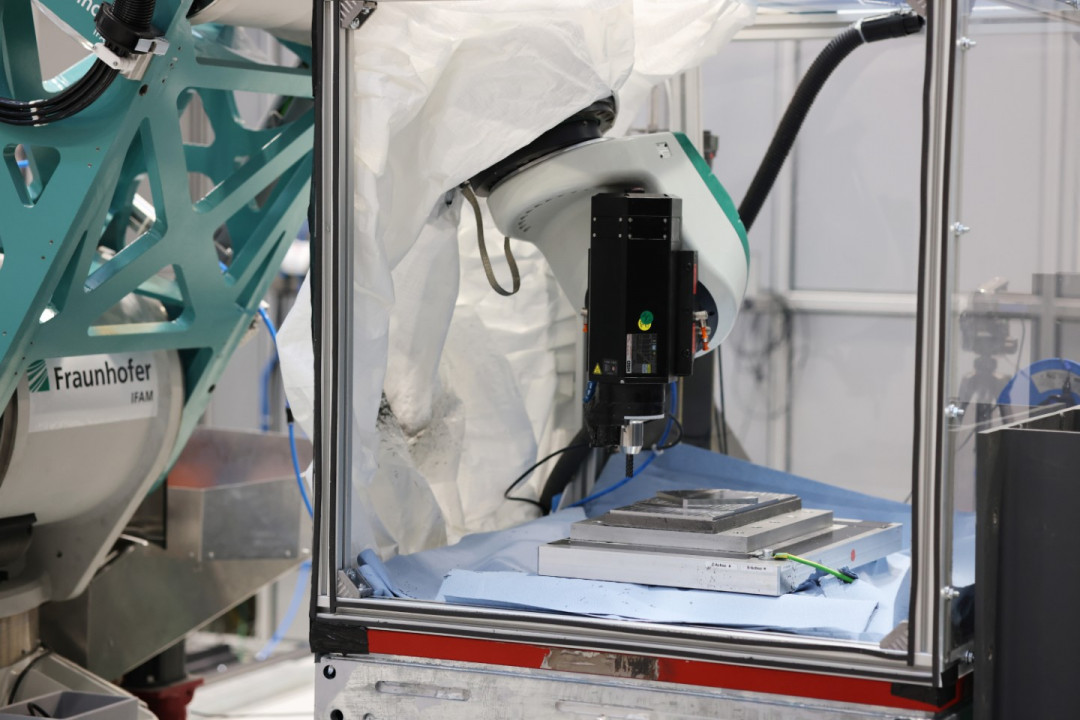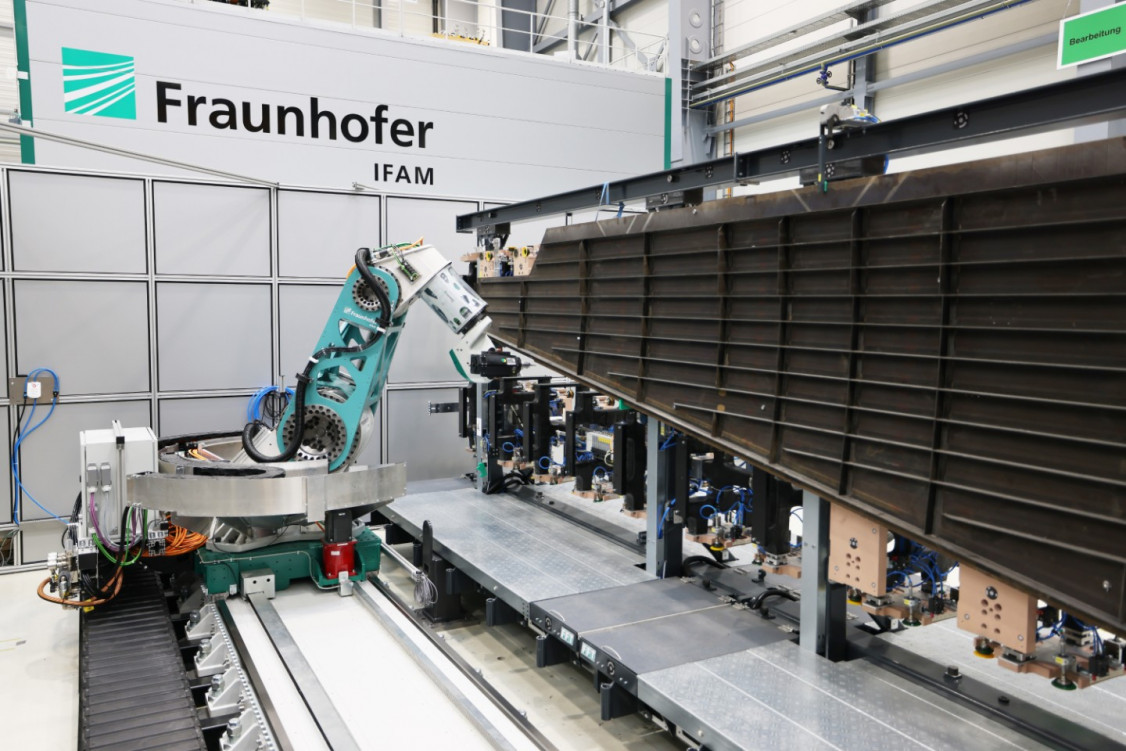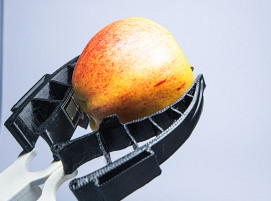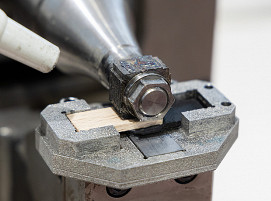
High-Precision Processing Robot with Innovative Drive Train
Newly developed milling kinematics on a linear axis enables versatile and efficient machining of lightweight materials to metals up to steel with a production tolerance of up to 0.1 millimeter The challenge of the successfully completed Lower Saxony LuFo project "Robots Made in Lower Saxony 2" ("RoMaNi 2") was to close the gap between industrial robots and machine tools. The result of the R&D work led by Fraunhofer IFAM in Stade, Germany, together with the project partners Broetje-Automation, Hexagon AICON ETALON and Siemens as well as the associated partners AIRBUS Operations and A&T Service is a high-precision machining robot with a new type of drive train, which not only enables the machining of lightweight materials, but also metals up to steel in a flexible and efficient manner with a production tolerance of up to 0.1 millimeter.
In the project, two robot kinematics designed for machining were examined in detail, optimized by control-side settings and metrological support for path-accurate processes and tested on a 1:1 scale using real applications from the aviation industry. As part of the RoMaNi 2 project, the researchers at Fraunhofer IFAM were able to completely assemble the prototype kinematics with a new type of hybrid drive that had already been developed in the "Flexible Kinematics 4.1" ("Flexmatik 4.1") project, put it into operation and test it in machining processes. Within the Fraunhofer joint project Flexmatik 4.1, the Fraunhofer IFAM, together with the Fraunhofer IPK and the Fraunhofer LBF, developed a robot with significantly improved dynamic properties enabling it to perform more challenging tasks, including the machining of harder materials. The RoMaNi 2 project concluded with the milling of a vertical tail plane of the associated partner AIRBUS and of a steel test item with high precision.
Serial flexible industrial robots and stationary high-precision machine tools
Serial industrial robots are characterized by their design, which enables flexibility and offers an advantageous ratio between the required installation space and the available workspace. Their use in various manufacturing and production processes proves to be efficient and versatile. In handling and assembly technology applications, they are established industrial solutions for the automation of process steps. Other areas of application, such as the machining of lightweight materials, are experiencing an increase in the use of industrial robots.

With increasing requirements due to harder materials or more demanding tolerances, however, industrial robots have their limitations because of their limited dynamic properties and higher compliance compared to machine tools. Because of their kinematic design, machine tools have a low compliance and high precision, but when scaled up to larger components in the meter range, this machine design requires a considerable amount of material and investment.
Machining large CFRP components on a 1:1 scale
In recent years, the use of new manufacturing processes has led to further developments in the design freedom and structural integrity of near-net-shape components made of carbon fiber-reinforced plastics (CFRP) in aircraft manufacturing. Due to the economic and technical requirements, high-precision post-processing of large components in the meter range with tolerances in the sub-millimeter range is usually carried out with large machine tools in gantry design. However, these machines have a considerable size depending on their kinematic structure, which often dictates the layout of the production facilities and limits their ability to react flexibly to changes in the production process.
An alternative machine concept is the industrial robot, including workspace expansion by means of a movable platform, the installation of several robots or the use of additional translatory axes such as linear axes. Compared to gantry systems or machine tools, this machine concept is much more space-saving and is not economically tied to individual large components. In addition, no special foundations are required, which facilitates the future adaption of production lines. In the RoMaNi 2 project, the prototype robot was combined with a linear axis for path-accurate robots, which was also developed in the Flexmatik 4.1 project. Although industrial robots have already been successfully used in the machining of thin aerospace shell components, increasing their robustness to process forces and their ability to handle increasingly demanding machining tasks is the next step for the growing use of industrial robots in the production of large aerospace components.
RoMaNi 2 – Hybrid drive leads to a significant improvement in the dynamic behavior of serial industrial robots
The experts for Automation and Production Technology at Fraunhofer IFAM assembled and investigated a prototype of a serial robot. The in-house developed kinematics is fundamentally designed to meet the requirements of processes with high path accuracy. The aim was to achieve manufacturing tolerances of at least ± 0.1 millimeter when machining large components from component one onwards. This prototype robot, including the linear axis, was developed as part of the Flexmatik 4.1 project, which ended with the fabrication of all components. The assembly of the entire kinematics, commissioning, control-side optimization and further development as well as the intensive investigation of the robot kinematics have now been successfully completed in the RoMaNi 2 project. Accuracy tests
on the prototype robot confirmed that the target of 0.1 millimeter was achieved.

A key element in improving the dynamic behavior of the prototype robot, in addition to structural optimization, is the use of an innovative drive concept in lower joint axes. By using an additional direct drive parallel to the conventional gear drive, a torque can be applied directly on the load side. This hybrid drive concept combines the possibility of compensating for undesirable effects of the gearbox and damping high-frequency excitations, while at the same time ensuring high energy efficiency in static and quasi-static load cases. The kinematics are controlled by a Siemens Sinumerik One controller. The widespread expertise in operating CNC machines can therefore be used without the need for retraining on new types of control systems. In the RoMaNi 2 project, control components for the hybrid drive were further developed so that the full potential of the drive can now be utilized in the industrial control system.
Wide range of applications by combining linear axis and robot with hybrid drive
The combination of serial articulated arm kinematics with a linear axis has various advantages over large gantry systems and special machines for machining. The smaller installation space and the modular design of the linear axis make the system highly flexible. The use of two preloaded rack and pinion drives compensates for reversal effects and achieves a sufficiently high drive stiffness of the linear axis carriage for path-accurate robot processes. Due to the high structural stiffness of the linear axis, the influences on the robot accuracy are low despite the large lever arms to the load application point. In the project, path accuracies of 0.15 millimeter were achieved for large components of up to 7 meters. The researchers at Fraunhofer IFAM are convinced that higher accuracy can be achieved by compensating for other static influencing factors, such as temperature, rather than compensating for other dynamic effects.
The use of direct drives significantly improves the reference tracking behavior and disturbance rejection of the serial robot kinematics at axis level. The direct mechanical transmission of the motor torques to the kinematics also allows increased jerk adjustment of all lower joint axes. This is 10 to 100 times higher than conventional robots with servo drives and therefore offers considerable potential for increasing productivity. In addition, a significant increase in path accuracy can also be demonstrated at high path speeds. At a feed rate of 10 meters/minute, a path accuracy in the range of the previously recorded static accuracy can be demonstrated. Damping of the first eigenmodes – caused by the gear drives – also offers the potential for improved disturbance rejection.
By machining a steel part, the project successfully took the next step in opening up new areas of application for industrial robots. The test part comprised various geometries such as corners, surfaces, and circles. It was machined using the machining parameters provided by the
tool manufacturer.
Perspectives
In the next step, the researchers at Fraunhofer IFAM together with partners from industry intend to further develop the new technology until it is ready for series production. There is a wide range of applications for industrial robots with hybrid drives: In combination with a linear axis, the spectrum ranges from machining tasks from the aviation industry, such as lighter fiber composite structures and aluminium alloys, to the machining of harder materials, such as steel or titanium, which are used, for example, in the rail, commercial vehicle and shipbuilding industries as well as in the energy sector. Until now, it has not been possible to machine such components and materials in an industrially robust manner using industrial robots. Particularly, the machining of hard-to-machine materials by industrial robots with hybrid drives appears to be very promising for the future.
(Source: Fraunhofer IFAM Press Release)






